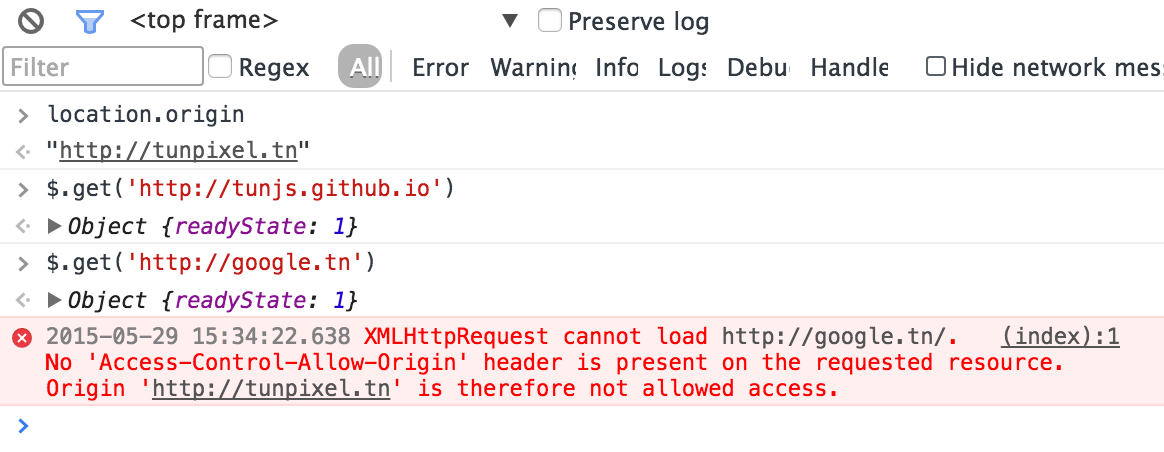Introduction to HTTP
TunJS - Mai 2015
Plan
- HTTP
- REST
- CORS
HTTP
The Hypertext Transfer Protocol (HTTP) is an application protocol for distributed, collaborative, hypermedia information systems. HTTP is the foundation of data communication for the World Wide Web.
HTTP
- an application-level protocol for end-to-end communication
-
used for communication between a client and a server
- a server could be a client too
- a client sends a request to server which replies synchronously with a response
HTTP Request
GET /archive HTTP/1.1
Host: tunjs.github.io
Connection: keep-alive
Accept: text/html,application/xhtml+xml,application/xml;q=0.9,image/webp,*/*;q=0.8
User-Agent: Mozilla/5.0 (Macintosh; Intel Mac OS X 10_10_3) AppleWebKit/537.36 (KHTML, like Gecko) Chrome/45.0.2416.0 Safari/537.36
Referer: http://tunjs.github.io/
Accept-Encoding: gzip, deflate, sdch
Accept-Language: en-US,en;q=0.8
Cookie: ...
BODY...
HTTP Request
METHOD PATH PROTOCOL_VERSION
HEADERS
BODY...
HTTP Response
HTTP/1.1 200 OK
Age: 0
Cache-Control: max-age=600
Connection: Keep-Alive
Content-Encoding: gzip
Content-Length: 981
Content-Type: text/html; charset=utf-8
Date: Fri, 29 May 2015 15:34:58 GMT
Expires: Fri, 29 May 2015 15:44:58 GMT
Last-Modified: Sat, 25 Apr 2015 14:06:51 GMT
Server: GitHub.com
Vary: Accept-Encoding
Access-Control-Allow-Origin: *
X-Cache: MISS
BODY...
HTTP Response
PROTOCOL_VERSION STATUS_CODE
HEADERS
BODY...
HTTP Headers
- a list of key-value.
- a request/response configuration
HTTP Methods
- HTTP method/verb indicate the nature of desired operation
-
GETused to retrieve information with no side effects (changing data)POSTsends data and executues operation which might change dataPUTPATCHDELETEOPTIONS- ...
- either safe of unsafe
HTTP Status Code
- a number for which is associated a message, e.g.
200 Ok400 Bad Request500 Internal Server Error- ...
- used to codify response state describing a situation regardin client, server or both
- falls in one of 5 categories: informational, successful, redirection, client errors and server errors
- custom status codes are supported as well
HTTP Status Code
- Informational (1XX)
- Successful (2XX)
200 OK201 Created
- Redirection (3XX)
301 Moved Permanently302 Found304 Not Modified
HTTP Status Code
- Client Error (4XX)
400 Bad Request401 Unauthorized403 Forbidden404 Not Found- ...
- Server Error (5XX)
500 Internal Server Error501 Not Implemented502 Bad Gateway503 Service Unavailable504 Gateway Timeout- ...
HTTP
References
REST
Representational State Transfer (REST) is a software architecture style consisting of guidelines and best practices for creating scalable web services. REST is a coordinated set of constraints applied to the design of components in a distributed hypermedia system that can lead to a more performant and maintainable architecture
REST
- ...
REST
References
CORS

CORS
Cross-origin resource sharing (CORS) is a mechanism that allows restricted resources (e.g. fonts, JavaScript, etc.) on a web page to be requested from another domain outside the domain from which the resource originated.
CORS
- Web clients implement a security policy that prevent loading assets from unallowed sources, thus preventing security attacks, most notably XSS.
- CORS solves this.